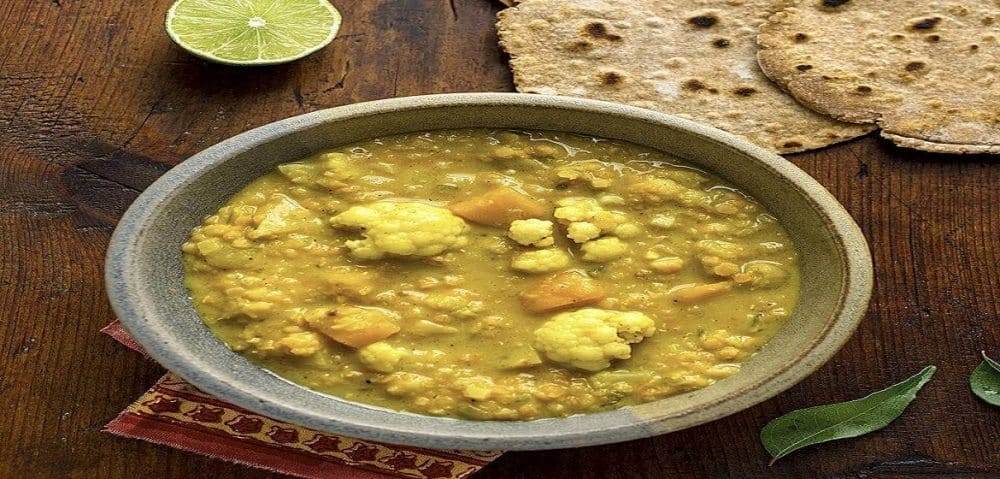This hearty and healthy recipe is easy to make and quite tasty too.
One fond memory that I have of my childhood is, naturally, food related. I remember, especially on rainy days, sipping on a cup of golden, spicy and piping hot daal. My mother would offer me a fresh, brimming mug of warmth and it would truly perk me up from the inside, all the way out to the tips of my wee fingers. It was a real treat that would stick to my bones and fill me right up. And that’s what this daal is — a quick, health-conscious and soul-warming meal that’s ideal for a chilly winter night or on a downtrodden and wet evening. Here’s my recipe.

Daal is a very popular dish within South Asian households. This recipe, in particular, incorporates many well-known South Asian ingredients, such as red lentils, which gives the dish its quintessential saffron hue, as well as squash and cauliflower. And, of course, for its signature flavours common pantry items like cumin, turmeric, mustard seeds, garam masala, ginger and garlic.
And so, when I found this recipe for a killer vegetarian daal, I was thrilled. Not only did this recipe make me nostalgic, it was also pocket-friendly, packed with hearty and healthy ingredients, and it really helps clear out the vegetable drawer. Feel free to switch up the vegetables that you incorporate into your version at home based on what you have on hand.
Check out the recipe below and try it out for yourself:
Ingredients
Salt, to taste
1 teaspoon ground turmeric
1 teaspoon brown mustard seeds
1 teaspoon cumin seeds
1 bay leaf
1 teaspoon garam masala
1 medium onion
1 Scotch bonnet pepper
4 garlic cloves
3 tablespoons fresh ginger
1 1/2 cup red lentils
2 cups butternut squash
2 cups cauliflower
1 to 2 potatoes, depending on the size
4 1/2 cups water
2 tablespoons lime juice
1 can coconut milk
2 tablespoons vegetable oil

Instructions
1. I like to do all my prep before I start to cook. Grab all the spices and measuring spoons; cut the onion using your preferred method; either slice the pepper and remove all of the seeds (or pop it in whole like I was taught to do); grate the ginger; mash the garlic (I prefer it mashed so I don’t get any chunks of it); wash the lentils thoroughly; and, lastly, peel and chop your veggies into bite-sized pieces.

2. On medium heat, add the vegetable oil (or you can substitute your preferred cooking oil). Once the oil is hot, toss in the mustard and cumin seeds. These seeds do not take long to heat up, and they will begin to pop fairly quickly. Once this happens, add the onion, garlic and ginger.
3. Keep your eye on the onions, and stir as needed. Once the onions have become translucent, you’re ready to proceed to the next step.
4. Add the lentils, water, coconut milk, salt, turmeric, the Scotch bonnet pepper and the bay leaf. Raise the heat to a medium-high temperature and bring the mixture to a boil. Don’t forget to stir so nothing sticks to the bottom.
5. When the mixture comes to a boil, gently combine some of the remaining ingredients: squash, cauliflower and the potatoes. Lower the temperature and allow the ingredients to simmer. Stir occasionally, but be careful not to break up the vegetables.
6. You’ll know the dish is ready to devour once the vegetables (particularly the potatoes) are tender (this will take about 15 to 20 minutes, depending on the size of your chopped up veggies). Once tender, turn off the heat, add the garam masala and the lime juice, and stir. At this point, you can either remove and discard the Scotch bonnet pepper, or if you’re feeling fierce, you can bust the pepper open and really add some fire to the dish (just don’t say I didn’t warn you: it’s not for the faint of heart.)

7. Optional: I also like to stir in some fresh spinach at the end. It really enhances the dish and ensures the spinach does not just melt away.
8. Serve and devour.
Main Image Photo Credit: www.eatingwell.com
Devika Goberdhan | Features Editor - Fashion
Author
Devika (@goberdhan.devika) is an MA graduate who specialized in Political Science at York University. Her passion and research throughout her graduate studies pushed her to learn about and unpack hot button issues. Thus, since starting at ANOKHI in 2016, she has written extensively about many challe...














































































































